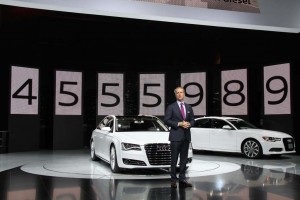
Audi of America CEO Scott Keogh with two new diesel models - and a sign suggesting the fuel the technology has helped owners save.
Audi will introduce four new diesel models in 2013, technology the maker says has already allowed its buyers to reduce their fuel consumption by nearly 5 million gallons in recent years.
But during a news conference at the 2012 LA Auto Show, U.S. Audi chief Scott Keogh took shots at state and federal regulators whom he accused of unfairly favoring battery-based technologies, rather than diesel, as a way to curb American dependence upon imported oil. He called on officials to take steps that would help boost demand for diesel powertrains in the U.S. – as is already the case in Europe.
“These are cars that demand no sacrifice,” proclaimed Keogh as he introduced the upcoming diesel versions of the Audi A6, A7, A8 and Q5 models. That’s a big part of the diesel pitch, as the latest versions of that technology can deliver significant performance and plenty of towing power, along with higher mileage. By comparison, hybrids and other battery-based technologies require trade-offs such as reduced performance or shorter range.
Diesel models, however, also command higher price premiums, like battery-based hybrids, plug-ins and pure battery-electric vehicles.
German automakers have been leading the push to bring diesel technology to the U.S. market. So-called “oil-burners” gained popularity here in the 1970s and 1980s, following twin Mideast oil shocks. But they quickly lost favor due to the problems with older designs, such as noise and smell. Virtually all those issues have been resolved with the more advanced diesels that came to the European market over the last decade or so.
In fact, diesels now account for about half the European market. In the U.S., however, limited availability – as well as customer caution and lack of government support – has meant that diesels are only slowly gaining traction. But demand is rising, in part due to increased consumer acceptance, but also due to the steady addition of new models, primarily from European makers including Mercedes-Benz, Porsche and Volkswagen, as well as Audi. Chrysler also plans to add a diesel or two, and General Motors will soon test the market with a diesel version of its Chevrolet Cruze.
With some models nudging over 40 mpg – and a few nudging into hybrid territory, proponents want to see regulators at the state and local level “level the playing field,” in Keogh’s words.
He noted that the latest U.S. Corporate Average Fuel Economy standard revisions – which will push average mileage to 54.5 mpg by 2025 – offer a number of incentives for battery technologies, such as credits that let manufacturers claim their vehicles get slightly better mileage than is actually the case. No such credits are available for diesels.
In California, which has set stringent new zero-emissions vehicle, or ZEV, standards favoring battery technology, the imbalance is even more significant. Keogh called on state regulators to give the highest-mileage diesels the same incentives as plug-in hybrids and battery cars – notably, access to the coveted HOV commuter lanes on state highways.
The executive said his company’s officials have been meeting with regulators hoping to gain some support for clean diesel — which he insists “is not just a viable solution but the best solution” to U.S. energy policy goals.
